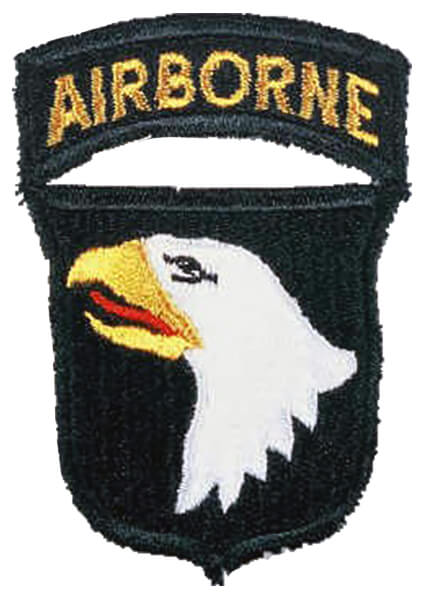| Page Created |
| August 16th, 2024 |
| Last Updated |
| August 16th, 2024 |
| The United States |
 |
| Additional Information |
| Unit Order of Battle Commanders Operations Equipment Multimedia Sources Biographies |
| Badge |
 |
| Motto |
| Screaming Eagles |
| Founded |
| August 16th, 1942 |
| Disbanded |
| – |
| Theater of Operations |
| North Africa Sicily, Italy Normandy, France The Netherlands Germany Austria |
| Organisational History |
As the United States enters the Second World War in December 1941, Colonel William C. Lee emerges as a leading advocate for airborne warfare. His interest in the potential of airborne troops solidifies over the previous year, particularly after studying the training methods used by smokejumpers, which he adapts as a model for military airborne training. With the backing of President Franklin D. Roosevelt, Lee is granted the authority to form the first paratroop platoon, commanded by William T. Ryder. This initiative quickly expands into the Provisional Parachute Group and eventually leads to the establishment of the Airborne Command, which Lee takes command of on March 21st, 1942. Shortly afterwards, on April 19th, 1942, Lee is promoted to brigadier general.
As the inaugural commander of the U.S. Army’s jump school at Fort Benning, Georgia, Lee plays a pivotal role in shaping the future of American airborne forces. His significant contributions are recognised with the Army Distinguished Service Medal, awarded for his “exceptionally meritorious and distinguished services to the Government of the United States, in a duty of great responsibility during World War II.”
On August 9th, 1942, Lee is promoted to major general and becomes the first Commanding General of the newly formed 101st Airborne Division, based at Camp Claiborne, Louisiana. Addressing his men, Lee declares, “The 101st has no history, but it has a rendezvous with destiny.”
The 101st Airborne Division, known as “The Screaming Eagles,” is officially activated on August 16th, 1942. The division is initially composed of the 502nd Parachute Infantry Regiment (PIR), the 327th and 401st Glider Infantry Regiments (GIR), the 377th Parachute Field Artillery Battalion (PFAB), and the 321st and 907th Glider Field Artillery Battalions (GFAB). These core units are supported by additional specialised units, including the 326th Airborne Engineer Battalion, the 101st Signal Company, the 326th Medical Company, and the 426th Quartermaster Company, forming a cohesive airborne force.
In October 1942, the division relocates to Fort Benning, Georgia, where the troops undergo rigorous training. At Fort Benning, the soldiers master both traditional infantry combat techniques and specialised airborne operations, including parachuting from aircraft and glider deployments. Initially, parachute troops and glidermen train separately, but by early 1943, these components are integrated into a unified fighting force.
In June 1943, the 506th Parachute Infantry Regiment (PIR), including the now-legendary Easy Company, is assigned to the 101st Airborne Division. That same month, the division participates in large-scale military manoeuvres, culminating in a July 1943 exercise that demonstrates their combat readiness. Following these successful manoeuvres, the division departs from New York on September 5th, 1943, bound for Great Britain to continue their preparation for the upcoming Allied invasion of Europe.
The division arrives in Great Briatain by the end of September, 1943 to prepare for the Allied invasion of Normandy, codenamed Operation Overlord. In January 1944, the 101st Airborne Division is assigned to VIII Corps, though it remains attached to the First Army.
Lee is deeply involved in planning the American airborne landings in Normandy and is determined to jump with his men during the invasion. However, on February 5th, 1944, while on his way to observe a training exercise by the 401st Glider Infantry Regiment, Lee suddenly experiences severe chest pain. Lieutenant Colonel Joseph “Bud” Harper, commanding the regiment, arranges for Lee to be evacuated to the 302nd Field Hospital, where doctors diagnose him with a serious heart attack. Despite the Army’s recommendation that he return to the United States for better treatment, Lee initially refuses, hoping to recover and resume command of the 101st Airborne Division, as Lieutenant General Omar Bradley promises to keep his position open.
On March 13th, 1944, the division is directly reassigned to the First Army. As D-Day approaches, British Prime Minister Winston Churchill witnesses a demonstration of the division’s capabilities in March 1944, further bolstering confidence in their readiness for Operation Overlord. Meanwhile, Lee’s condition deteriorates, and in March 1944, he suffers a second heart attack, forcing his return to the United States. By late 1944, Lee is retired from the Army due to ill health.
With Lee’s departure, the question of who will command the 101st Airborne Division arises. Initially, Brigadier General Don Pratt, the division’s assistant commander, assumes temporary command and expects to lead the division into battle. However, General Dwight D. Eisenhower, the Supreme Allied Commander, has other plans. While Brigadier General Anthony McAuliffe, the division’s artillery commander, is considered, Eisenhower ultimately chooses Brigadier General Maxwell D. Taylor to take command of the 101st Airborne Division. Taylor, who gains valuable combat experience while leading the 82nd Airborne Division Artillery during the campaigns in Sicily and Italy, is seen as the ideal leader to guide the division through the impending battles in Normandy and beyond. Under Taylor’s command, the 101st Airborne Division goes on to play a crucial role in some of the most significant operations of the Second World War.
In May 1944, the division moves to various airfields across England, preparing for their critical role in the invasion. On June 5th, 1944, General Dwight D. Eisenhower visits the troops, offering encouragement before they board 1,432 C-47 Dakota aircraft for the mission to Normandy.
On June 6th, 1944, the 101st Airborne Division makes its combat debut during Operation Overlord, parachuting into Normandy behind Utah Beach. Despite fierce resistance, the division captures key locations, including Pouppeville, Vierville, and St. Côme-du-Mont. By June 12th, 1944, they secure the vital town of Carentan, ensuring a critical connection between the Utah and Omaha Beachheads. After achieving their objectives, the division is reassigned to VIII Corps, First Army, and returns to England on July 13th, 1944 for rest and further training. On July 15th, 1944, the division is reassigned to the Ninth Army, reflecting its evolving role as the Allied campaign progresses through France.
In preparation for Operation Market Garden, the 101st Airborne Division is assigned to XVIII Airborne Corps, First Allied Airborne Army, on August 12th, 1944. On September 17th, 1944, they participate in one of the largest airborne operations of the war, landing in Holland as part of the British XXX Corps, British Second Army. Over the following days, the division secures key objectives, including the capture of Vechel, the securing of the Zon bridge, and the towns of Sint Oedenrode and Eindhoven. However, the battle for Opheusden proves challenging, with the town changing hands multiple times before the enemy finally withdraws on October 9th, 1944. Throughout these operations, the division is reassigned several times: to British I Airborne Corps on September 21st, 1944, British VIII Corps on September 23rd, 1944 and British XII Corps on September 28th, 1944. After these intense engagements, the division returns to France on November 28th, 1944 for further training and preparation for the winter campaign.
As the German Ardennes Offensive begins, the 101st Airborne Division is rapidly deployed to Belgium on December 17th, 1944. They are reassigned to the First Allied Airborne Army but attached to VIII Corps, Third Army, 12th Army Group, as they move to defend the critical town of Bastogne. Under the temporary command of Brigadier General Anthony C. McAuliffe, the division establishes a defensive perimeter around Bastogne. Despite being completely surrounded, the 101st Airborne Division famously refuses to surrender on December 2nd, 1944, holding the line until the 4th Armored Division arrives to relieve them on December 26th, 1944. Afterward, the division is reassigned to III Corps, Third Army, on December 26th, 1944, before being moved back to VIII Corps on December 29th,1944.
In early 1945, the 101st Airborne Division remains under the First Allied Airborne Army but is reattached to the Third Army, 12th Army Group, on January 19th, 1945. The following day, they are reassigned to XV Corps, Seventh Army, 6th Army Group, and on January 26th, 1944, they move to VI Corps, continuing operations in Alsace and conducting defensive patrols along the Moder River. On February 28th, 1945, the division returns to XVIII Airborne Corps, First Allied Airborne Army. By April 1st, 1945, the division is reassigned to XXII Corps, Fifteenth Army, 12th Army Group, and just days later, on 6 April, they come under the direct command of the 12th Army Group. On April 17th, 1945, the 101st is Airborne Division reassigned to Seventh Army, 6th Army Group, and then to VI Corps on April 23rd, 1945, continuing their advance through Germany.
By May 4th, 1945, as the war in Europe draws to a close, the 101st Airborne Division is reassigned to XXI Corps, Seventh Army, 6th Army Group. The division reaches Berchtesgaden by the end of the war, where they perform occupation duties until their inactivation in Germany.
